They say… 
Best beer and travel writing award 2015, 2011 -- British Guild of Beer Writers Awards
Accredited Beer Sommelier
Writer of "Probably the best book about beer in London" - Londonist
"A necessity if you're a beer geek travelling to London town" - Beer Advocate
"A joy to read" - Roger Protz
"Very authoritative" - Tim Webb.
"One of the top beer writers in the UK" - Mark Dredge.
"A beer guru" - Popbitch.

|
Top Tastings 2011
ABV: 7.3%
Origin: Manchester, England
Website: www.marblebeers.co.uk, www.fullers.co.uk
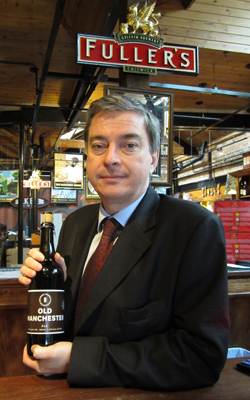 Fuller's head brewer John Keeling with Marble Old Manchester. "Old and from Manchester." Pic: Fuller's Collaboration beers are especially popular among the new generation of craft brewers, often across national boundaries, and have produced some fascinating results. But here’s one that crosses the generations, bringing together one of Britain’s leading old established independent breweries with one of its most impressive new arrivals, and also connecting two of the country’s greatest cities. It’s a beer that brought John Keeling, who has kept London’s Fuller’s in the first rank of world breweries, back to his native Manchester to create something rather special with James Campbell at the innovative Marble brewery.
Old Manchester Ale – “I like this beer because it’s like me, old and from Manchester!” comments John – is actually partly inspired by a London beer, Fuller’s own ESB, a favourite at Marble for its mix of juicy malt and assertive hops. When it was introduced in 1971, ESB replaced a long established Burton ale, not a light coloured India-style pale but a darker, sweeter beer in a style that originated in Burton but was once commonly brewed across England. It seems possible that ESB inherited some of its predecessor’s characteristics with its deep colour and rich maltiness.
Old Manchester turns the ESB volume control up a little and brings some twists of its own. It’s notably higher in gravity, and hopped with English Challenger, although I suspect some piny US hops have been included too. Both hop character and smoothness have been underlined by dry hopping the beer in cask and maturing for three months before bottle conditioning in Marble’s handsome Bordeaux-style bottles.
The beer is a lovely nut-brown colour with hints of amber, and a fine foamy light beige head. A beautifully fruity aroma has piney hop notes which, alongside the toffeeish, biscuity malt character, made me think of a modern US brown ale. There’s a grapefruit note on the palate which is dead dry and biscuity, though still contrives to be toffeeish, with a few lightly charred and burnt rubber hints, subtley softened by tasty fruit.
The biscuity quality persists in a finish where the piney notes recede under more fruit and a lingering peppery hop bite, lightly warming alcohol and some late candy notes. The beer is available in limited quantities – I found mine at the Pigs Ear beer festival but it’s also stocked by Marble and at the Fuller’s Brewery Shop.
Top Tastings 2011
ABV: 5%
Origin: Santa Rosa, California, USA
Website: www.moonlightbrewing.com
 Moonlight Death & Taxes Black Beer The name refers to the old proverb about certainty, attributed among many others to Benjamin Franklin. And it’s a quality that I’ve come to associate over the past few years with Moonlight beers – the certainty that the beer I’m about to taste is at least interesting and quite likely excellent.
Most people I’ve spoken to who’ve also encountered Brian Hunt’s beers feel the same, yet they’re limited to a modest production – only about 1,000 US barrels (1,200hl) a year, and with distribution over a limited area. Brian started the brewery in 1992 in an old barn in the countryside north of Santa Rosa, in Sonoma County on the outlying flanks of the San Francisco Bay Area. It moved to a purpose built facility closer to town in 2003. There are no bottles – Brian insists the beers taste their best only in kegs.
Moonlight beers are artisanal, eccentric and distinctive without shouting out for attention like some more notorious Californian craft brews. The fact that the flagship beer, Death & Taxes, is an inspired take on a Schwarzbier sums up the approach.
The beer is a very dark brown, near black, with a foamy beige head and a rich chocolatey dark malt aroma. A very firm but clean and smooth palate is dry and sacky with little sweetness, some coffee and chocolate flavours and a bit more hops than expected, but not overwhelmingly so. A long developing and perfectly controlled and balanced chocolate and bitterish roast finish turns powdery on the tongue. It’s sophisticated and flavourful but still wonderfully refreshing.
I sampled the beer during another very pleasant session at one of my favourite San Francisco beer venues, the Monks Kettle in the Mission.
Top Tastings 2011
ABV: 4.9%
Origin: London W10, England
Website: moncadabrewery.co.uk
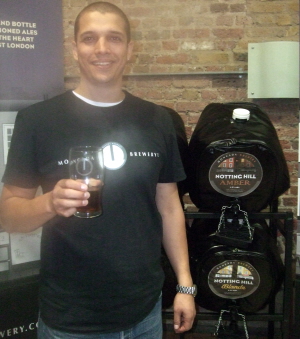 Julio Moncada at the London Brewers Showcase, October 2011 2011 was an extraordinary year for brewing in London. When I sent the final text of London’s Best Beer, Bars and Pubs off to CAMRA Books in early March, I felt the capital had done well to nurture six new brewers over a matter of years, particularly when they included Brodie’s, Camden Town, Kernel, Redemption and Sambrook’s. Then at the end of March I heard another new brewery, Moncada, was under development in west London.
I phoned up a rather surprised Julio Moncada, and discovered he was a former caterer from Argentina, who had originally planned to open a delicatessen business but then opted for brewing instead, partly as the ingredients were nearer to hand. I then wrote a last minute couple of paragraphs on the basis that Moncada beers would be on sale by publication date, feeling rather pleased with myself for producing something with its finger so firmly on the pulse.
As it happens, things turned out rather differently. In the succeeding months, it sometimes seemed I was hearing about yet another planned new London brewery on a weekly basis. Meanwhile Julio’s plans were delayed by trade mark and electricity supply problems, and several other newcomers such as Botanist, By the Horns, East London, London Brewing, London Fields and Redchurch beat him to it, with a rush of new openings in late summer and early autumn.
Moncada beers made their public debut on 22 October at the London Brewers Showcase organised by the London Brewers Alliance at Brew Wharf, Borough Market. This remarkable event included nearly all the new brewers alongside more established names including London’s remaining old established independent, Fuller’s. When I say that Sambrook’s, who couldn’t make it, were barely missed, it’s not at all a reflection on the quality of their beer but on the huge growth of the capital’s brewing industry.
I was glad to meet Julio face to face at the event and gladder still to taste his excellent beers, which really were worth waiting for. Notting Hill Amber was his first brew, served on cask but also available in the bottle, and a very promising start. It’s in this list of Top Tastings partly on its own merits, but also as a representative of all the new brewers that emerged in perhaps the most exhilirating year in living memory for the London’s beer scene.
My sample was a soft hazy amber with a fine white head and a very finely pointed hoppy aroma of grapefruit and exotic spice. A smooth, full and tasty palate turned rapidly bitter with grapefruit over underlying malt and a slightly petrolly note, first cakey and then slightly raspy on the tongue. The finish was bitterish and chewy but nicey rounded with a tasty smack of fruit and a little astringency. Long may the brewers of my home city keep producing such great beers.
Top Tastings 2011
ABV: 3.7%
Origin: Maldon, Essex, England
Website: www.mightyoakbrewery.co.uk
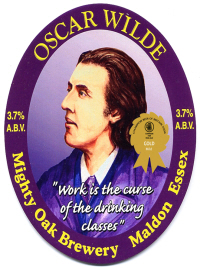 Mighty Oak Oscar Wilde This beer won Champion Beer of Britain (CBoB) at the Great British Beer Festival in August 2011, much to the consternation of some craft beer aficianados who saw this as further evidence of CAMRA conservatism and fustiness – with all those exciting new high gravity beers out there dry hopped with massive quantities of the latest alpha acid oozer from New Zealand, here they are giving their top award to a dull old 3.7% traditional English mild.
For my part, I was more than happy with the choice. I’m a great fan of mild, which, although it’s not quite in as imminent danger of extinction as it once was, is still a minority style, and at its best a brilliant demonstration of how brewers can squeeze remarkable amounts of flavour into a low gravity beer. Admittedly the CBoB judges sometimes make eccentric choices and tend towards conservatism, but all they can do is pick what they think are the best beers that are offered to them out of a wide variety on the day.
Much as I was pleased to hear of Oscar Wilde’s win, however, the main reason it’s here is more personal. Shortly after 1800hrs on Thursday 3 February 2011, I completed my exhausting schedule of research visits to potential places to drink for inclusion in The CAMRA Guide to London’s Best Beer, Pubs and Bars by calling in at Leyton Orient Supporters Club.
Due to the irregular opening hours of the club, I’d not succeeded in visiting it on previous research itineraries, and had even considered not bothering with it, but in the end I was glad I made a special effort. It’s certainly not London’s most beautiful place to drink, but it’s an unexpectedly quirky venue with an excellent range of cask ales at bargain prices and a very warm welcome from the enthusiastic volunteers who run it. It seemed a good place to draw a line under my quest for the capital’s best beer outlets.
As had become my standard practice with places new to me, I went in unannounced as an ordinary drinker, ordered a half and took stock of both the beer and the surroundings. Then before taking more detailed notes I introduced myself to bar manager Mike Childs and explained what I was doing. We ended up chatting further, and when Mike found out his club was my last stop he insisted I stay for a pint on the house by way of celebration. I unhesitatingly chose one of their regular beers, Oscar Wilde Mild.
Its brewery, Mighty Oak in the pretty Essex town of Maldon, on the Blackwater estuary, has a firm link to east London brewing heritage. It was founded in Brentwood, just over the London boundary, in 1996 by brewer John Boyce, who had been made redundant through the closure by Carlsberg of the Ind Coope brewery in Romford, one of the great historic ale breweries of the region with a history dating back to 1709. Reaching for the aspiration of its name, the tiny brewery prospered and moved to its current, much bigger, premises in 2001.
It’s unusual these days for a brewer in southeast England to do well with a mild but Oscar Wilde is an exception. Mild may also not have been the tipple of choice for the flamboyant Irish poet, playwright and wit with whom it shares its name, but of course it’s Cockney rhyming slang – not that I’d miss the opportunity of raising a glass to Oscar himself.
The beer is a very, very dark amber brown with a light foamy beige head and a malty, sappy, slightly caramel tinged aroma of the precise sort you’d expect from a good example of the style. There’s also a bit of caramel on the malty palty, with some liquorice and a touch of ashy roast, offset by a pleasant fruity tanginess on the tongue. A nice drying and slightly roasty finish has a bit more brown bread flavour with notably bracing hops around the edges – perhaps a bit more than would be typical in more traditional examples, but not enough to overpower the firm malt character.
I’ve found Oscar Wilde delicious on several occasions and this was no exception, though perhaps with an extra boost of pleasure given the task I’d just accomplished. If this beer is in the gutter, it is certainly looking up at the stars, and I urge you to follow its gaze.
 Cask or craft? Can Boris tell the difference? Opening of Lovibonds brewery 2006, with brewer Jeff Rosenmeier (right). Pic: Lovibonds This is the first in what will undoubtedly become an occasional series of posts addressing some of the theoretical and policy debates currently besetting British beer culture. If your interest in beer is entirely in drinking and enjoying it, then I recommend you read no further. However for those that are interested, what follows isn’t just rabbinical hair-splitting. Such debates can, and have, had a major impact on the way beer is produced, marketed, consumed and appreciated.
What do we mean by craft beer and craft brewing? And more specifically, what do I mean by these terms, which I use regularly on this blog and in my other writing? The issue has arisen because it’s becoming increasingly apparent that, in the British context, not everyone uses the terms in the same way.
When I write “craft beer” I’m thinking globally, across international brewing cultures and irrespective of particular brewing techniques. To me, a craft brewer is one who prioritises brewing as a craft, using quality ingredients, skill, experience and imagination to produce beers of character and distinctiveness, whether that’s by adhering to deep-rooted local brewing traditions or innovating with new and experimental recipes and styles.
This definition is inevitably fuzzy-edged and requires a certain amount of value judgement and insight into particular brewers’ intentions, and it’s easy to think up particular cases to test it. And of course brewery staff have to make a living, so commercial considerations enter into the decision making of even the most artisanal producers. But I do think there is an important and useful distinction to be made between this vision of craft brewing on the one hand, and large scale industrial brewing on the other, where decisions are primarily driven by the need to pay dividends to shareholders who otherwise have little interest in brewing, and branding and marketing techniques are at least as important as brewing skills.
I admit my definition doesn’t correspond with some of those used by bodies that are more authoritative and influential than me. The term ‘craft brewing’ originated in the United States in the 1980s to designate the emerging counterpoint to the prevailing dominance of large-scale monopolised national brewing, encompassing both new brewers producing more flavoursome beers and the handful of old-established local and regional brewers that had survived Prohibition and postwar consolidation.
Originally US brewers and drinkers used the term as fuzzily as I do, but the Brewers Association (BA), the trade organisation for smaller, independent brewers, needed a less disputable definition. The BA now defines a craft brewer primarily by size, as a brewer producing up to 6million US brewers’ barrels (just over 7million hl) – raised in 2011 from 2million barrels (2.35million hl) when some of the Association’s most successful members came within reach of the previous threshold. Volumes like these have little relevance to the UK where, for example, the three breweries owned by the world’s biggest brewer, AB InBev, produce barely 11million hl between them and a major independent like Fuller’s is unlikely to chalk up more than 500,000hl a year.
The BA definition does, however, go on to specify that a craft brewer must also be independent, with no more than 25% ownership by a non-craft alcohol producer, and either produce an all-malt flagship beer or dedicate at least half of its production to “either all malt beers or…beers which use adjuncts to enhance rather than lighten flavor”. This last stipulation arose from the US context where industrial brewers took to using significant proportions of ingredients like maize (corn), rice and refined sugar to create blander mainstream beers. But within that context, it begins to address the issue of quality, and the significance of brewing tradition.
Given the differences in both scale and historical context, there’s little to be achieved in attempting to force the BA definition onto the UK brewing scene. But it’s notable that there’s nothing in the BA definition that specifies particular technical aspects of beer production, like fermentation, conditioning and dispense, and certainly nothing to preclude cask beer – the traditional British style of draught beer that is still fermenting in its container when dispensed without additional carbon dioxide pressure – from being counted as craft beer. Indeed while cask beer accounts for a tiny proportion of production in the US, interest in it is growing among craft brewers.
Yet in Britain there are growing signs the term is being used more narrowly, to exclude cask beer. This confusing new usage has arisen partly to fill a vacuum in terminology that’s been exposed by changes in the beer market. When CAMRA coined the term “real ale” in the early 1970s to distinguish traditional British cask ale from the new low quality, low alcohol, cheaply produced and overpriced pasteurised and artificially carbonated draught “keg” ales and lagers that were being foisted on the drinking public through the monopoly positions and marketing budgets commanded by the industrial brewing groups, the overlap between cask beer and beer worth fighting for was almost exact.
In the early 1970s, CAMRA publications such as the first Good Beer Guide (1974) defined “real ale” more broadly, including quality considerations such as adequate conditioning periods and the avoidance of cheap adjuncts, extracts and chemical additives, alongside cask conditioning and unpressurised dispense. But the messages were soon simplified, and generations of British beer drinkers grew up with the notion that whether a beer was “good” or not was somehow entirely determined by the presence of live yeast cells and the absence of extraneous CO2.
This oversimplification was always problematic, leaving out for example considerable numbers of British bottled beers that though filtered and sometimes pasteurised had a least as much tradition behind them as cask ales. In recent decades it’s become more and more unsustainable, challenged first by increasing awareness and availability of international beers of self-evident quality that don’t fit the definition of “real ale” and now by still small but growing and influential numbers of small and high principled British brewers producing beers that don’t fit the real ale parameters.
The rather clunky term “craft keg” is in relatively common use to describe such beers in draught form, encompassing both domestic and imported brews. The techniques used in producing and dispensing some of these beers challenge easy categorisation. Unlike industrial keg beers they are not necessarily pasteurised and artificially carbonated – many are unpasteurised, some are conditioned in the keg and with some the natural carbonation produced during fermentation is captured and added back in later to aid a sparkling dispense. Their brewers can make a good case that, for some beer styles, the additional sparkle and the generally lower serving temperatures enhances the taste experience rather than compensating for the lack of it, as with industrial keg beers. But they still don’t count as real ale.
It’s perhaps unsurprising, then, that people reach for the simple term “craft” to designate non-cask beers of this kind. Here’s Robin Walton, author of The Search For The Perfect Pub: Looking For The Moon Under Water, writing on the Huffington Post website on 9 January 2012:
Craft beer isn’t real ale. In fact, in some ways it’s the antithesis of real ale. Where real ale might be (fairly) represented by scenes of beer festivals populated by lovable old Gandalfs, craft beer might be two demented blokes driving a tank up Camden High Street to promote a bar launch…Where real ale is cask and handpull, craft beer will proudly pour from the keg or the bottle.
Admittedly the tone of the article is lighthearted, and Robin later admits he is making “huge, sweeping generalisations”. His reference to real ale drinkers as “lovable old Gandalfs”, and, later in the article, to young people and women drinking craft beer, suggests he’s talking about cultural perceptions as much as about technical definitions. Nonetheless a newly minted beer enthusiast reading the article might at best end up confused, and at worst be prompted to avoid cask beer, which Robin implies, perhaps unintentionally but nevertheless completely mistakenly, is less flavourful than “craft” beer from keg or bottle.
Yet this confusing usage is in danger of spreading even to brewers. Soon after the above article was published, US-born Jeff Rosenmeier of Lovibonds in Henley-on-Thames, one of the small breweries now specialising in “craft keg” beers, caused a stir on Twitter by stating that what he brewed was craft beer, as distinct from real ale. “You have craft beer,” tweeted Jeff, “and you have real ale (cask). Including real ale as craft beer just confuses things…real ale is bedded in, people know it. Why does real ale get included?” Jeff seemed to be saying that beers like his deserve a category of their own, and “craft” is that category.
While I’m sympathetic to brewers like Jeff wanting to boast about their excellent beers in their own right and not just as a subcategory of something else, I disagree strongly that the way to do this is by attempting to claim exclusive rights to the term “craft beer”. Education of the consumer matters, and terms like “real ale”, far from being “bedded in”, are widely misunderstood – they may be familiar to people like Jeff, myself and other members of the beer twitterati that participated in the exchange, but what about those new beer drinkers potentially excited by the flavour potential of both cask and non-cask craft-brewed beer?
Exempting cask beer from the craft category would send out the unhelpful implication that cask beer isn’t crafted, which is patently untrue. Although there are a handful of high volume bland brews out there from bigger brewers that might stretch our generosity a little, by and large cask beer is crafted by definition, given the greater levels of care and skill required to brew and serve it compared to industrial pasteurised beer.
More importantly, anyone constructing a definition of craft beer around the question of whether it is or is not cask will fall into precisely the same trap that has ensnared CAMRA ever since it attempted to define the value of beer according to the technicalities of conditioning and dispense. While it’s undeniable that CAMRA’s approach has brought great success, which brewers and drinkers of both cask and non-cask craft beers should be grateful for, that success came at a price.
For forty years since, rather than focusing on beer quality and integrity, CAMRA has been riven by divisive, destructive and ultimately rather pointless debates about detailed technical issues that mean nothing to the average drinker, from an early furore about air pressure dispense that almost split the organisation, through endless hours of anguish about cask breathers and “fast cask” yeast, to the current craft keg debate and its resulting terminological impasse.
Surely, as several contributors to the Twitter discussion suggested, we should be concentrating on the things that really matter when deciding whether or not a beer is worth drinking or celebrating – its quality, flavour, distinctiveness, provenance, appropriateness to occasion, its sense of tradition or indeed of imagination, and other factors that speak to whether or not it was brewed with pride, and craft.
We can be sure the categories will come – they’ll be foisted upon us by marketing people, most of whom know little and care less about the technicalities and traditions of brewing, not to inform the public but to help “grow the category” and assist supermarket staff in deciding which shelves to put the bottles on. And doubtless those of us who care about such things will fulminate online about how inaccurate and unhelpful they are, just as we do when we see Leffe Blonde and Erdinger Weissbier labelled as lagers or read that a beer has been brewed to the same recipe for a thousand years. But please let’s not give such confusion and misinformation a head start.
Top Tastings 2011
ABV: 10.1%
Origin: London SE1, England
Website: www.thekernelbrewery.com
 The Kernel Brewery Beers from the Kernel, surely London’s second world class brewery, loomed large in my drinking in 2011. I admit I was a bit late in catching up on them – my first encounter was in January when I visited the brewery as research for my London beer guide, by which time the online beer enthusiast community had been buzzing about them for months.
I could easily have picked three or four Kernel beers as Top Tastings – including the 1890 Export Stout that my fellow judges and myself named top beer at the International Beer Challenge last summer. Several of British Guild of Beer Writers Brewer of the Year Evin O’Riordan’s other beers are reviewed elsewhere, but I’ve limited myself to one choice per brewery for the Top Tastings. The Export Stout seemed a shoe-in until a few weeks ago, when I happened on this Imperial Brown Stout, another historic recipe, on sale in the bottle – bottle conditioned as always – at the Pigs Ear Beer Festival.
The beer pours a very dark brown, with a thick orange-brown head leaving copious amounts of lace. There’s a very smooth and tempting aroma dominated by chocolate, with hints of plummy fruit and cream. Chocolate and stewed prunes are evident in a rich palate with a wonderful garnish of fruity hops dancing over thick caramel and liquorice malt, with tingling alcohol, spices and dark treacle sweetness.
The finish is lingering, elegant and complex, first coating the mouth with a sticky slick of cakey malt, with chocolate, coffee and mint flavours and a long developing but contained charred roast note complementing the sting of alcohol. A very big flavoured and challenging beer, but with much to enjoy.
Top Tastings 2011
ABV: 8.1%
Origin: Lewes, East Sussex, England
Website: www.harveys.org.uk
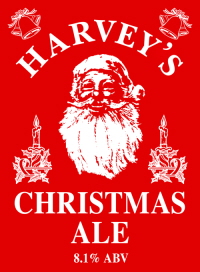 Harveys Christmas Ale The end of 2010 and the beginning of 2011 found me tasting an unusually large number of British cask ales as I worked my way round potential places to drink for my London guide. Normally, to preserve as clear a head as I could when visiting up to 21 pubs in one day, I’d pick something low gravity and limit myself to a few sips. I made a point of paying a special visit even to places I already knew very well, just to make sure I had all the information I needed for the book, including the famous White Horse in Parsons Green SW6, where I found myself early in January. When I saw the cask version of Harvey’s classic seasonal strong ale on the bar, I gladly made an exception to my usual rule, buying a half and drinking the lot.
The beer, which is also available all year round in a filtered, bottled version, is described by the brewery as a barley wine which recalls 18th and early 19th century stock ales of the sort that were laid down in better off households. I suspect the recipe has undergone a certain amount of modernisation, but it’s still a traditional treat.
Christmas Ale is a deep burgundy colour, with a light bubbly head. The aroma is relatively restrained, with pronounced fruity and toasty malt notes. A rich, sweet and oily but all too drinkable palate has cherry fruit, with light wood hints and emerging almond flavours. A tasty, nutty and fruity finish is long and gently warming with drying woody vanilla flavours and lightly tangy hop resins. The beer is actually relatively heavily hopped, but at such a high strength and with good residual sweetness, the bitterness is balanced out.
I also have a tasting note from a bottle I tried a few years back, which I found had a creamy off-white head, a cakey vine fruit aroma with hints of angelica, a full and slightly treacly and vinous palate with some light fruit, plum and coffee, and a little peppery dryness, orange peel and mincemeat in the finish. I suspect the relatively higher carbonation in the bottle offsets the sweetness and brings out a little more of the hops.
The bottled version was good, but the draught was stunning, and well worth keeping an eye out for at the right time of year.
Top Tastings 2011
ABV: 13%
Origin: Chicago, Illinois, USA
Website: www.gooseisland.com
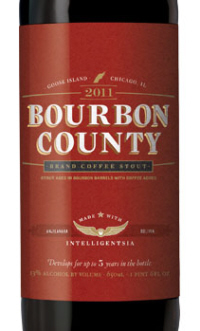 Goose Island Bourbon County Brand Coffee Stout I’ve been a fan of Chicago’s Goose Island beers ever since receiving some review samples of their pale ales when they were first imported to the UK (see Goose Island Honker’s Ale), and their pioneering wood matured beer Bourbon County Stout is one of the best in its style I’d ever tried. Like many other fans I read with trepidation about their takeover by Anheuser-Busch InBev last year, and continue to hope the world’s biggest brewer will break with its bad old habits and see the value in preserving the integrity of a genuine craft brewery.
That integrity must include retaining special releases like this astonishing special edition of Bourbon County made with coffee beans from a renowned specialist coffee roaster, Intelligentsia, next door to the brewery. The 2010 bottling was the beer’s first appearance, made with stout brewed in 2008 and aged for around 15 months in former Heaven Hill bourbon barrels, then infused with Black Cat Espresso coffee beans from Intelligentsia; subsequent releases have each used different coffee varieties.
This near-black beer had a very dark fawn head, with a fine texture and only a small amoutn of lace. An intense, spiritous and slightly woody dark and roasty aroma had hints of vanilla, whisky and a fleeting coffee whiff. The palate was chewy and oily with raisins, with cakey malt bread, ginger in dark chocolate, a curious thick advocaat-like note and, of course, coffee, but the beer wasn’t at all overwhelmed with espresso flavour, which remained in perfect balance to the other elements. Coffee also wafted over a slight gritty and very sticky raisiny fruit finish.
I’m grateful to Dan Fox who, as retiring landlord of the White Horse, Parsons Green, shared this rare bomber bottle of a truly astonishing beer with me after a beer tasting event.
Top Tastings 2011
ABV: 3.8%
Origin: Cairndow, Argyll & Bute, Scotland
Website: www.fyneales.com
 Fyne Ales Jarl Cask golden ales are now as ubiquitous in Britain as traditional bitter, and most, it’s sad to say, make for relatively bland, if refreshing, drinking. One of the ways some of them are marking themselves out is by leaning towards the US style of pale ale, particularly in their choice of hops, engaging new drinkers looking for more flavoursome beers without alienating the old guard of real ale quaffers.
I tasted a handful of very good examples of this trend in 2011 but the one that stays in the mind most is Jarl, launched as a summer seasonal in 2010 by one of Scotland’s most impressive and improving small breweries, Fyne Ales, established in 2001. The apparently immodest brewery name is justified as the beer is made in farm buildings in a picturesque setting at Achadunan, overlooking Glen Fyne and the head of Loch Fyne, with water drawn from a nearby burn.
Jarl’s name commemorates the Norse earls that once occupied much of Scotland, but its flavour profile is highly contemporary, making good use of the new Citra hop. It’s a very pale clear yellow beer with a fine white head and a striking kiwi fruit aroma, well supported by broad creamy notes. The drying palate retains the fruity note, with more exotic fruit flavours like lychees and the bitter zest of pink grapefruit. A very bittering zesty finish also reveals lovely sweet fruity malt beneath, with peppery notes emerging.
It’s a delightful example of its type, with so much more complexity than the average one-note hoppy golden ale. I sampled it in fine condition at the Pot Still specialist whisky bar in Glasgow, which I’m pleased to see is also now offering a much improved beer selection in a city that’s becoming a seriously good place to drink.
Top Tastings 2011
ABV: 8.5%
Origin: Placentia, California, USA
Website: www.thebruery.com
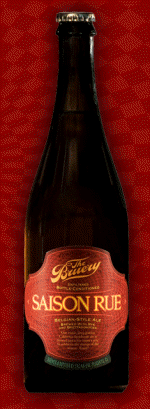 The Bruery Saison Rue The Bruery gets its name from a pun on the family name of founder Patrick Rue, and was first employed to designate his home brewing kit during his days as a law student. It was ported over when, having decided a career in brewing might offer more life satisfaction than a career in law, Patrick went commercial in 2008. The name seems curiously appropriate for an operation that’s both ambitious and still decidedly artisanal and idiosyncratic, focusing on distinctive and flavoursome unpasteurised beers, including Belgian-inspired and sour ales, often robust in alcohol, designed to match with food and conditioned in handsome 750ml bottles.
Located in Orange County, in the suburban sprawl around Los Angeles, the Bruery is a key name among a growing number of operations watering what was once something of a desert in one of the most craft beer-minded states. But its reputation is spreading much further, with Patrick tipped as a brewer to watch by US beer gurus like Sam Calagione.
Saison Rue is the closest the Bruery gets to a regular flagship beer. Inspired by both Wallonian saisons and Northern French bières de garde, this multiple award winner adds its own twist by including malted rye in the grist and a wild Belgian yeast strain in the final conditioning, giving it interesting ageing potential. I seized on the chance to buy a bottle – at a price – at the Great British Beer Festival in 2011.
The beer was a deep amber gold, rather lively with a fine creamy orange-tinged white head. Yeasty strawberry fruit and wet plastic wild yeast notes were apparent on a malty aroma with an emerging classic European hop character. The palate was very dry and very complex, though with notes of softening fruity sweetness. Spicy rye, herbal flavours and very slight sourness integrated perfectly with firm cereal malt and estery, almost varnish like alcoholic tones. A spicy, hoppyish finish had a slick of toffee malt, toast and herbal detergent notes and lasting vegetal hoppy dryness.
I wish I’d had the discipline to stash this splendid beer away for a couple of years as it clearly had the potential to age into something even more complex. But even relatively young, it’s a fine new saison, and a shining example of how US craft brewers are reinventing what were once obscure and declining beer styles from rural European backwaters.
|
Cask  This pioneering new book explains what makes cask beer so special, and explores its past, present and future. Order now from CAMRA Books. Read more here. This pioneering new book explains what makes cask beer so special, and explores its past, present and future. Order now from CAMRA Books. Read more here.
London’s Best Beer  The fully updated 3rd edition of my essential award-winning guide to London’s vibrant beer scene is available now from CAMRA Books. Read more here. The fully updated 3rd edition of my essential award-winning guide to London’s vibrant beer scene is available now from CAMRA Books. Read more here.
|














